Pros
Cons
Introduction
Note: The model we got our hands on at the CP+ convention in Yokohama Japan was officially called the iVIS HF R31, which is the Japanese equivalent of the Vixia HF R32 camcorder (yes, we know the naming conventions are stupidly confusing). Other than the difference in model name, the American HF R32 comes only in black, while the Japanese HF R31 comes in silver or red.
Video Review
{{section_header}}{{section.name}}{{/section_header}}
Lens & Imaging System
{{section_header}}{{section.name}}{{/section_header}}

Canon put a new lens on its entry-level "R-series" camcorders this year, and the results are likely to impress people who love fiddling around with extensive optical zoom. The HF R32 has a 32x optical zoom lens, which is over 50% more zoom than Canon featured on last year's HF R21 (20x zoom). This zoom can be cranked up to 51x when using Canon's advanced zoom feature.
The HF R32's image sensor underwent a more modest redesign compared to last year's R21. At 1/4.85-inches, it's the same size CMOS with the same total pixel count of 3.28 megapixels. Canon did claim it did a few tweaks with the sensor placement and design, but it should only translate to a subtle improvement in video performance—we'll see if that's actually the case when we get the R32 into our labs later this year.
Front
{{section_header}}{{section.name}}{{/section_header}}
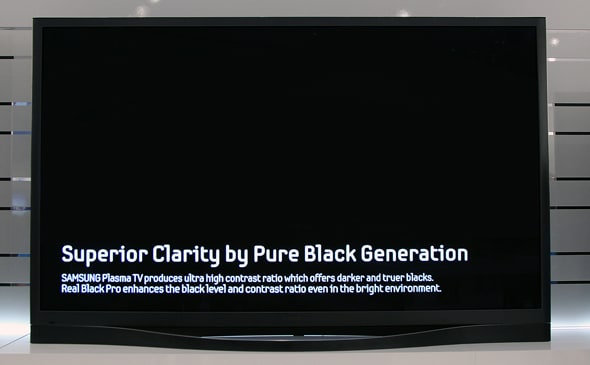
Right
{{section_header}}{{section.name}}{{/section_header}}
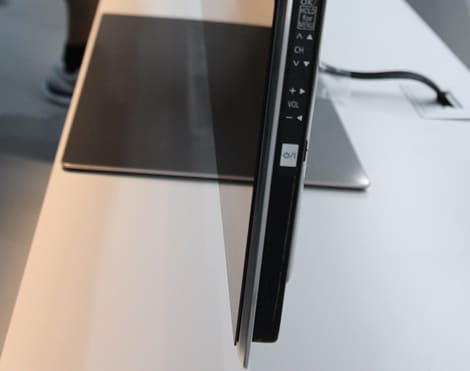
Back
{{section_header}}{{section.name}}{{/section_header}}
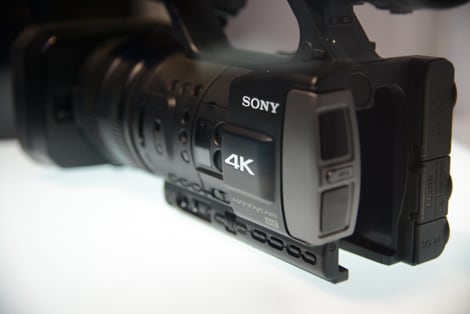
Left
{{section_header}}{{section.name}}{{/section_header}}
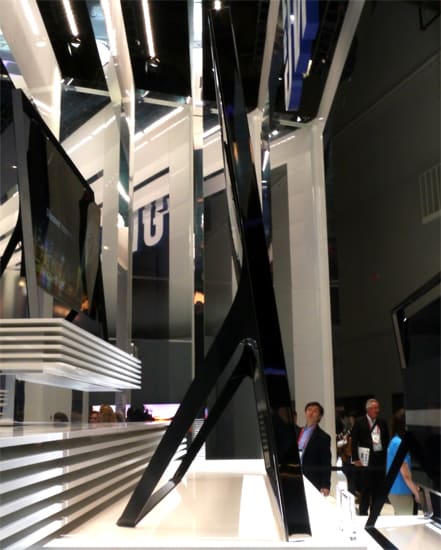
Top
{{section_header}}{{section.name}}{{/section_header}}

Bottom
{{section_header}}{{section.name}}{{/section_header}}
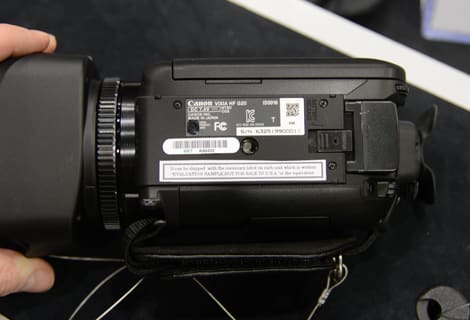
Compression
{{section_header}}{{section.name}}{{/section_header}}
One of Canon's most significant changes on the HF R32 is the addition of an MP4 recording option as well as AVCHD recording. Canon decided to include MP4 recording on its new crop of Vixia camcorders mainly to have a format that is easy to share and upload wirelessly using the new WiFi function on select Vixia camcorders. Offering MP4 recording also gives users flexibility during post production, as it gives people more options for recording formats (if you don't have an editing program that can work with AVCHD, for example).
Read more about the advantages and disadvantages of different compression types.
Two of the HF R32's record modes offer Full HD 1920 x 1080 recording (the highest-quality AVCHD modes). The rest of the AVCHD record modes offer 1440 x 1080 HD recording, and the two MP4 modes record 1280 x 720 HD images. Consult the table below for complete information about the R32's recording options.
Media
{{section_header}}{{section.name}}{{/section_header}}
Just like the HF R21 before it, the HF R32 is packed with 32GB of internal flash memory. That's the most memory you'll find loaded on any of Canon's new R-series camcorders. The HF R30 has just 8GB of internal memory, while the HF R300 comes with no internal memory.
Read more about the advantages and disadvantages of different media types.

Canon simplified the R32 this year by reducing the amount of memory card slots on the camcorder down to one card slot. There were two slots on last years R21, and, while we like the flexibility of having two card slots, we'd rather have the simpler and more compact design that the R32 offers thanks to its lack of a second card slot. The card slot still works with SD, SDHC, or SDXC memory cards, and combining one card with the camcorder's 32GB of internal flash memory should give you plenty of recording time. Canon claims you should be able to record just under 3 hours of video at the highest quality setting on the R32's internal memory alone (lower quality settings will let you record for much longer as well).
Auto Mode
{{section_header}}{{section.name}}{{/section_header}}
Canon continues to improve its Smart Auto features on its Vixia camcorders every year, and with an entry-level model like the HF R32 it's likely that many users will be shooting with this dedicated auto mode the majority of the time. According to Canon, the Smart Auto function has a catalog of 38 different shooting situations that the camcorder can automatically identify and use. The system doesn't always work perfectly, but we found it switched between regular and tele macro mode effectively, and the R32 did a reasonably good job adjust exposure levels under mixed indoor lighting.
In addition to the Smart Auto mode, you can also control the R32 automatically in Program mode. Program mode gives you more controls to play with, but exposure is still set automatically unless you go into the menu system and adjust it yourself. Scene modes are available in lieu of Program mode on the R32 as well.

Zoom
Focus
{{section_header}}{{section.name}}{{/section_header}}
Focus is one of the few controls that can be set manually on the HF R32. The system for manipulating focus isn't great, as it involves tapping buttons on the LCD touchscreen, but at least the option is there for consumers. Autofocus is probably the better bet for most users, and the HF R32 offers some control that goes beyond the regular autofocus format. There's spot focus that lets you tap the portion of the screen you want to bring into focus (essentially a very simple manual focus mode), face detection that will focus and exposure people's faces properly, and a focus tracking feature that locks onto a subject and tries to keep them in focus for as long as they're within the frame.
Exposure
{{section_header}}{{section.name}}{{/section_header}}
Basic exposure adjustments can be made manually on the HF R32, but the camcorder does not offer full control over aperture, shutter speed, or gain. If you want that kind of control, you'll have to upgrade to Canon's mid-range or high-end Vixia models (like the HF M52 or HF G10).
White Balance
{{section_header}}{{section.name}}{{/section_header}}
In addition to a fully manual white balance option, the HF R32 has two white balance presets (daylight and tungsten) and an auto white balance setting. Honestly, we'd like to see more white balance presets than just two options (like a setting for fluorescent light, maybe), but at least the HF R32's "one-push" manual white balance function is easy to set.
Color & Image Controls
{{section_header}}{{section.name}}{{/section_header}}
The Cinema Mode options on the HF R32 are a combination of color controls and digital effects that enable you to give your videos a different look and aesthetic. The Cinema Mode settings include the following: standard, vivid, cool, nostalgic, sepia, old movie, and dramatic black and white. We like some of these options, but some are gimmicky and useless. Either way, we're happy to see Cinema Mode brought to the HF R32 this year (but the options aren't as extensive as what you get on Canon's higher-end camcorders).
Other Manual Controls
{{section_header}}{{section.name}}{{/section_header}}
Canon brought the Story Creator function to the HF R32 this year, which, like the Cinema Modes, is a feature previously reserved to higher-end Vixia models. Story Creator is a template system that helps you organize and collect shots in order to tell a better "story" and a make a better video overall. The feature requires a ton of dedication to use, and we expect most users to ignore it entirely, but it's an interesting feature nonetheless.
Ease of Use
{{section_header}}{{section.name}}{{/section_header}}
With the HF R32, Canon placed focus on automatic controls and easy-to-use functions rather than full-fledged manual controls. This makes the camcorder rather simple to use when the dedicated auto mode is engaged, but we did find some of the more advanced settings rather confusing. Once we turned the Smart Auto feature off, the menu grew more complex and more confusing. It's very likely that the R32's extensive menu system, which got a few cosmetic updates this year, will be seen as too confusing for novice videographers.
By adding new features like MP4 recording modes and WiFi capability, Canon made the HF R32 a more challenging camcorder to figure out, while at the same time creating a more robust model. From the outside, the camcorder definitely looks simple to work with. There aren't many buttons on the body itself, and everything is positioned and labeled well. It's the touchscreen menu systems that are difficult to navigate, and you're forced to work with a variety of menu screens if you want to delve deep in to the R32's controls and features.
Handling
{{section_header}}{{section.name}}{{/section_header}}
We mentioned the HF R32 can be a tough camcorder to work with thanks to its long menus and complex feature sets, but as far as the layout and design of the model, Canon did an excellent job. We liked the way the camcorder felt in our hand during our brief time with it on the show floor at CP+ in Japan. Even though the hand strap looks small and flimsy, it provided a good amount of support when we gripped the camcorder—and it felt comfortable as well.
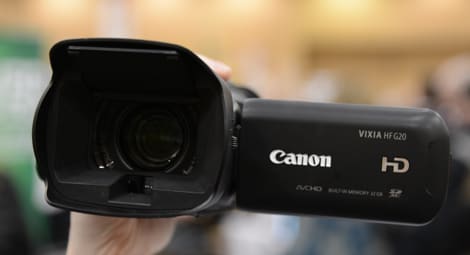
The zoom toggle and record button are positioned well on the camcorder, and the position of the DC-input on the lower corner of the R32's right side was more or less out of the way when we gripped the camcorder in our hand. The ports on the inside of the LCD cavity aren't protected incredibly well, but that's common to see on an entry-level camcorder.

One new button on the HF R32 is Canon's "Home" button, which is clearly modeled after Apple's popular button of the same name on its iPods and iPhones. The idea of the "Home" button is that it brings you to a main menu screen whenever you press it. It's a great concept in theory, and we definitely used the button a lot when we got lost in the R32's extensive menus. But there was something about the Home button that just didn't feel right. The placement of the button may have something to do with its odd feel. It's inside the LCD cavity, which is far away from the rest of the menu buttons (all of which are part of the touchscreen interface). So, when you're working within the menu system on the touchscreen and want to go back to the "Home" screen, you have to move your finger to a completely different location on the camcorder. Canon should have put the "Home" button front-and-center, maybe at the base of the LCD panel, to avoid this issue.

Stabilization
{{section_header}}{{section.name}}{{/section_header}}
For the HF R32, Canon decided to upgrade to an optical image stabilization system (OIS) rather than sticking with the digital system offered on last year's HF R21. OIS is often seen as superior to digital stabilization, and OIS systems don't lead to the slight image degradation that can be present when using digital stabilization.
In addition to switching over to OIS, Canon also implemented a huge number of stabilization options on the new HF R32—including an automatic stabilization detection system called Intelligent IS. The new function will automatically select a stabilization mode based on the shooting conditions (just like Smart Auto will select a scene mode automatically). The various stabilization modes the camcorder selects from include Dynamic IS, Powered IS, Macro IS, and tripod mode. If you don't like the camcorder making the decision for you, then you can turn off Intelligent IS and manually select a stabilization mode instead.
Portability
{{section_header}}{{section.name}}{{/section_header}}
The HF R32 a bit smaller and lighter than its predecessor, and Canon made this possible mostly by removing some excessive features from the R32. The new camcorder only has one memory card slot (the R21 had two), it lacks a Component-out port, and it has a redesigned battery compartment (and uses a different battery pack than last year's HF R21). The result is a camcorder that's around 30g lighter and more compact than its 2011 equivalent.
Battery
{{section_header}}{{section.name}}{{/section_header}}
The R32 comes with a BP-709 rechargeable battery pack—a completely different battery than what Canon included on last year's Vixia models. The new battery means also means a different battery compartment for the camcorder, which is something we're very happy to see. The HF R21 had an enclosed battery compartment (see it here), which meant you couldn't load the camcorder up with larger, longer-lasting battery packs.
The R32, however, has an open compartment that will fit not only the camcorder's provided battery, but also two larger battery packs that Canon makes for the camcorder (the BP-718 and BP-727). After consecutive years of abysmal battery life performances from Canon's entry-level HD models, we're very pleased to see the company making changes to the battery design. Hopefully the battery life performance on the HF R32 will show improvement over last year, but even if it doesn't the newly designed battery compartment is getting our approval anyway.

LCD & Viewfinder
{{section_header}}{{section.name}}{{/section_header}}
The specs for the HF R32's LCD aren't any better than screen on last year's HF R21. It's a 3-inch touchscreen with a resolution of approximately 230,000 pixels. But, Canon did alter the look of the touchscreen by incorporating a flat, even bezel rather than a screen that sits indented into the panel by a few millimeters. This design actually makes the touchscreen interface a bit easier to use (we found it more responsive) and it makes the swiping navigation system for the menus easier to work with thanks to the glossy coating on the screen. It won't make your videos loo any better, though, and the new screen does attract slightly more glare.



Menus
Audio Features
{{section_header}}{{section.name}}{{/section_header}}
Canon is known for including more audio features on its entry-level camcorders than the competition, so the HF R32 has more audio controls than you get on most models in its price range. The camcorder not only has an external mic and headphone jack, but it also has full-fledged audio level control, a wind screen feature, and a microphone attenuator—essentially the same audio controls that Canon includes on its mid-range Vixia models (the HF M series).
The built-in microphone records 2-channel stereo, but the audio compression is different depending on what recording mode you shoot with. AVCHD recordings use Dolby Digital AC3 compression, while MP4 clips record audio with MPEG-2 AAC encoding.

Connectivity
Conclusion
Canon's updates to the HF R32's sensor and processing system were minimal, so we don't expect to see a huge improvement in performance compared to last year's HF R21. What does impress us, however, are the simple design modifications Canon made to the HF R32 that make it a more compact and lighter model than its predecessor. Unfortunately, the camcorder felt a bit more difficult to use than last year's entry-level Vixias, but much of that frustration came from new features (like the built-in WiFi) that Canon didn't implement all that smoothly.
Still, the HF R32 looks more stylish and feels more powerful than most entry-level HD camcorders. It's $549 price tag isn't all that cheap, but the fact that it comes with 32GB of built-in flash memory does offset the extra cost just a bit. The HF R32 also has more features, more connectivity options, and better handling than most entry-level camcorders—another reason its cost is a bit higher than the competition. Hopefully the video performance will be a step above the competition as well, as a solid performance from this camcorder should be expected based on its higher-than-average price tag. We'll find out later this year for sure, once we get the Canon HF R32 into our labs for a full-length review.
Photo Gallery
{{photo_gallery "FI Lens Image", "FI Front Image", "FI Right Image", "FI Back Image", "FI Left Image", "FI Left Open Image", "FI Top Image", "FI Bottom Image", "FI Media Image", "FI Easy Mode Image", "FI Zoom Image", "FI Zoom Image 2", "FI 3D Lens Image", "FI 3D Lens Image 2", "FI 3D Physical Controls", "FI 3D Physical Controls 2", "FI Handling Image", "FI Handling Image 2", "FI Handling Image 3", "FI Battery Image", "FI LCD Image", "FI Viewfinder Image", "FI Viewfinder Image 2", "FI Playback Image", "FI Mic Image", "FI Flash Image", "FI Photo Mode Image", "FI Ports Image 1", "FI Ports Image 2", "FI Ports Image 3", "FI Ports Image 4", "FI Ports Image 5", "FI Ports Image 6"}}
Specs
{{manufacturer_specs_table}}
Meet the tester
Jeremy is the video expert of our imaging team and Reviewed.com's head of video production. Originally from Pennsylvania and upstate NY, he graduated from Bard college with a degree in film and electronic media. He has been living and working in New England since 2005.
Checking our work.
Our team is here to help you buy the best stuff and love what you own. Our writers, editors, and experts obsess over the products we cover to make sure you're confident and satisfied. Have a different opinion about something we recommend? Email us and we'll compare notes.
Shoot us an email